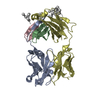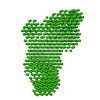+Search query
-Structure paper
| Title | Structural Basis for Antigen Recognition by Transglutaminase 2-specific Autoantibodies in Celiac Disease. |
|---|---|
| Journal, issue, pages | J Biol Chem, Vol. 290, Issue 35, Page 21365-21375, Year 2015 |
| Publish date | Aug 28, 2015 |
 Authors Authors | Xi Chen / Kathrin Hnida / Melissa Ann Graewert / Jan Terje Andersen / Rasmus Iversen / Anne Tuukkanen / Dmitri Svergun / Ludvig M Sollid /   |
| PubMed Abstract | Antibodies to the autoantigen transglutaminase 2 (TG2) are a hallmark of celiac disease. We have studied the interaction between TG2 and an anti-TG2 antibody (679-14-E06) derived from a single gut ...Antibodies to the autoantigen transglutaminase 2 (TG2) are a hallmark of celiac disease. We have studied the interaction between TG2 and an anti-TG2 antibody (679-14-E06) derived from a single gut IgA plasma cell of a celiac disease patient. The antibody recognizes one of four identified epitopes targeted by antibodies of plasma cells of the disease lesion. The binding interface was identified by small angle x-ray scattering, ab initio and rigid body modeling using the known crystal structure of TG2 and the crystal structure of the antibody Fab fragment, which was solved at 2.4 Å resolution. The result was confirmed by testing binding of the antibody to TG2 mutants by ELISA and surface plasmon resonance. TG2 residues Arg-116 and His-134 were identified to be critical for binding of 679-14-E06 as well as other epitope 1 antibodies. In contrast, antibodies directed toward the two other main epitopes (epitopes 2 and 3) were not affected by these mutations. Molecular dynamics simulations suggest interactions of 679-14-E06 with the N-terminal domain of TG2 via the CDR2 and CDR3 loops of the heavy chain and the CDR2 loop of the light chain. In addition there were contacts of the framework 3 region of the heavy chain with the catalytic domain of TG2. The results provide an explanation for the biased usage of certain heavy and light chain gene segments by epitope 1-specific antibodies in celiac disease. |
 External links External links |  J Biol Chem / J Biol Chem /  PubMed:26160175 / PubMed:26160175 /  PubMed Central PubMed Central |
| Methods | SAS (X-ray synchrotron) / X-ray diffraction |
| Resolution | 2.4 Å |
| Structure data |  SASDA28:  SASDA38:  SASDA48:  PDB-4zd3: |
| Chemicals |  ChemComp-HOH: |
| Source |
|
 Keywords Keywords |  IMMUNE SYSTEM / IMMUNE SYSTEM /  transglutaminase 2 / transglutaminase 2 /  antibody / antibody /  Fab fragment / Fab fragment /  celiac disease celiac disease |
 Movie
Movie Controller
Controller Structure viewers
Structure viewers About Yorodumi Papers
About Yorodumi Papers




